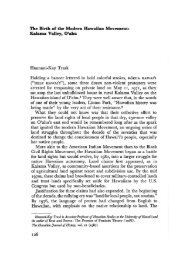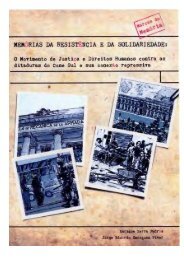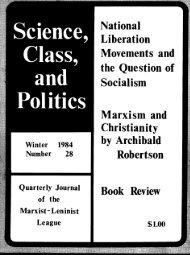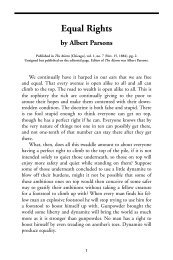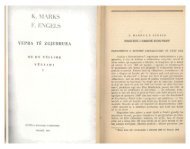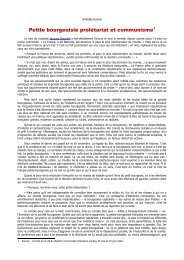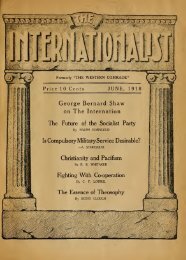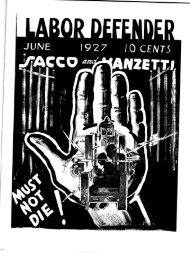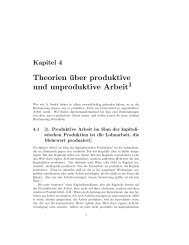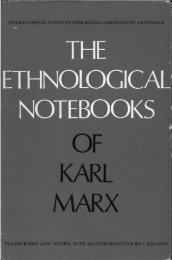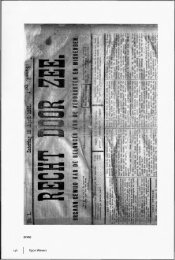The Stalin school of falsification - Marxists Internet Archive
The Stalin school of falsification - Marxists Internet Archive
The Stalin school of falsification - Marxists Internet Archive
You also want an ePaper? Increase the reach of your titles
YUMPU automatically turns print PDFs into web optimized ePapers that Google loves.
<strong>Stalin</strong> School <strong>of</strong> Falsification -- Chapter 9<br />
May, 1927, to present their point <strong>of</strong> view on the Anglo-Russian Committee, the Chinese Revolution, and<br />
the situa tion in the Soviet Union. For having done so, they were removed from the E.C.C.I. in violation<br />
<strong>of</strong> its statutes. [BACK TO TEXT]<br />
50. By the time Trotsky was delivering this speech, it was p05 sible to draw a complete balance sheet <strong>of</strong><br />
the Anglo-Russian Trade Union Unity Committee, which was dissolved by the with drawal <strong>of</strong> the British<br />
trade union leaders sometime in May, 1927, after they had squeezed out <strong>of</strong> it every possible political<br />
advan tage to themselves. See also, Note 82. [BACK TO TEXT]<br />
51. <strong>The</strong> Black Hundreds was the name given to the arch-reactionary and monarchistic "Union <strong>of</strong> the<br />
Russian People" which ter rorized revolutionists and instigated anti-Semitic pogroms under the rule <strong>of</strong><br />
the Czar. [BACK TO TEXT]<br />
52. <strong>The</strong> "Declaration <strong>of</strong> 88" was handed to the Central Committee <strong>of</strong> the Communist Party <strong>of</strong> the Soviet<br />
Union on May 26, 1927 by G. Yevdokimov, G. Zinoviev, I. T. Smilga and L. Trotsky in the name <strong>of</strong> 88<br />
old revolutionists. <strong>The</strong> declaration was a summary <strong>of</strong> the Opposition's point <strong>of</strong> view on the decisive<br />
questions in dis pute in the Soviet Party. Among its signers, the year <strong>of</strong> whose adherence to the party is<br />
given in parentheses, were: Beloborodov (1907), Visnevskaya (1905), Vuyovich (1912), Vassiliev<br />
(1904), Vardin (1907), A. Gertek (1902), N. Gordon (1903), Yemelianov (1899), Yevdokimov (1903),<br />
Shuk (1904), Zinoviev (1899), Zaks-Gladnev (1906), Kuklin (1903), Kavtaradze (1903), Lizdin (1892),<br />
Muralov (1908), Ostrovskaya (1905), Piatakov (1910), Radek (1902), Serebriakov (1905), I. N. Smir nov<br />
(1899), Samsonov (1903), Sosnovsky (1903), Ter-Vagan yan (1912), Kharitonov (1905), Sharov (1904),<br />
Tsibulsky (1904), Eltsin (1898). <strong>The</strong> declaration was speedily signed by several hundred names. [BACK<br />
TO TEXT]<br />
53. It is to be found in the Jahrbach fur Sozialwissenchaft und Sozialpolitik, published by Dr. Ludwig<br />
Richter, Zurich, 1879, pp.54-75 and is entitled "Der Isolirte Sozialistisehe Staat" von G. V[ollmar]. In<br />
setting forth his view, Vollmar, prominent spokesman for the Right wing <strong>of</strong> the German social<br />
democracy in his time, wrote: "I believe-and shall seek to demonstrate it in the following pages-that the<br />
final victory <strong>of</strong> socialism is not only historically more likely primarily in a single state, but that nothing<br />
stands in the road <strong>of</strong> the existence and prosperity <strong>of</strong> the isolated socialist state." (P. 55) [BACK TO TEXT]<br />
54. <strong>The</strong> "<strong>The</strong>rmidorian chapter" <strong>of</strong> the French Revolution opened up on the 9th <strong>of</strong> <strong>The</strong>rmidor (July 27,<br />
1794) when the counter revolution effected its dramatic coup by the execution <strong>of</strong> the rev~~ lutionary<br />
Jacobins, Robespierre, Saint-Just, Couthon, Lebas and others. <strong>The</strong> term is applied by Trotsky to<br />
conditions socially analogous in the Russian Revolution, meaning the growth <strong>of</strong> social, economic and<br />
political reaction occurring under the old structural forms and banners. [BACK TO TEXT]<br />
55. <strong>The</strong> Menshevik attitude towards the "liberals," that is, the "progressive bourgeoisie," was<br />
fundamentally different from the attitude <strong>of</strong> the Bolsheviks, or <strong>of</strong> Trotsky. <strong>The</strong> Mensheviks saw the basic<br />
problem <strong>of</strong> the coming revolution in Russia as that <strong>of</strong> the alliance <strong>of</strong> the proletariat with the bourgeoisie<br />
against feudalism and for the establishment <strong>of</strong> a democratic, parliamentary bourgeois republic, in which<br />
the working class and its party would constitute the Left wing, in approximately the same way as the<br />
socialist parties <strong>of</strong> France, England and Germany func tioned in' their bourgeois republics or parliaments.<br />
<strong>The</strong> Bolsheviks saw the. problem as one <strong>of</strong> an alliance <strong>of</strong> the proletariat with the peasantry against the<br />
industrial bourgeoisie, for the establish ment <strong>of</strong> a "democratic dictatorship <strong>of</strong> the proletariat and peas<br />
antry." Trotsky saw the problem <strong>of</strong> the alliance in exactly the same way as the Bolsheviks, but differed<br />
http://www.marxists.org/archive/trotsky/works/1937-st2/sf09.htm (19 <strong>of</strong> 21) [06/06/2002 15:07:02]




